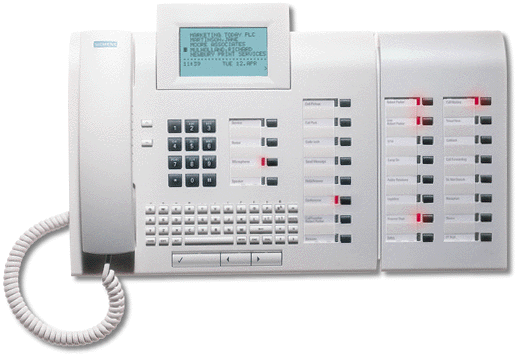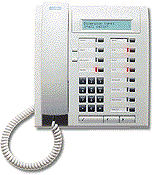 |
| Siemens :System telephones |
|
| Optiset Memory E |
The top model for
frequent telephone users
|
 |
| Optiset Comfort E |
The
professional equipment for voice and data communication.
|
 |
| Optiset Standard E | |
The comprehensive range of features for telephoning
|
 |
| Optiset Entry E |
-For low cost entry into digital technology.
|
| Key Module & Adaptor Concept | |
Add-on terminal for the direct
utilisation of additional features and
stored numbers at the press of a button.
Dimensions in mm (W x D) 135 x 253 One or 2 key modules can be connected in each case to the Comfort 100 E and Memory 100 E telephone solutions.Adapter concept The Hicom 100 E adapters are slide-in modules of the system telephones Comfort 100 E and Memory 100 E. They provide a flexible expansion option for your system telephone, using individual add-on components. In this way you can maximise the functionality of your workstation.Acoustic Adapter. Allows you to connect telephone accessories: active loudspeaker box; second earphone; add-on microphone.Analogue Adapter. Is used to connect analogue terminals (such as a telephone, Group 3 fax or modem) to the system telephone. |
Contact Adapter. Allows
you to control busy lamps (e.g. "do
not enter") and second ringers (in noisy surroundings or
outdoors).
Control Adapter. This is used to connect a headset and a PC for CTI programmes (Computer Telephony Integra-tion) which support dialling and TAPI.Data Adapter. Allows you to connect a PC (V.24 inter-face) directly to the system telephone. You can then dial from the PC for the telephone.ISDN Adapter. Allows you to connect standard ISDN components (e.g. a PC with an S 0 card or video equipment).Headset Adapter. Can be connected to the system telephonevia the headset adapter. Headset plus Adapter. Allows you to connect a head-set and a cassette recorder for local call recording.Phone Adapter. Enables another system telephone to be connected to the system without an additional cable (e.g. for seating area). The telephones can be reached via independent directory numbers. |
|
|
| [Home Page] | [Telecom Solutions] | [IT Solutions] | [Contact Info] | [Company Profile] |
[News] |